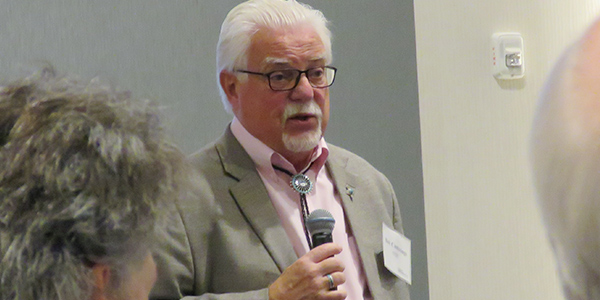By John Funk
MINNEAPOLIS — A frequency response study that NERC engineers began more than two years ago to model the potential impact on the Eastern Interconnection of replacing old coal power plants with wind and solar resources has reached a tentative conclusion that may present market issues to the developers of renewable energy.
The study has concluded that wind and solar generators, which precisely synchronize their power flows into the transmission system with electronic inverters, can respond to frequency disruptions far more quickly than a traditional synchronous machine response, which is based on the speed of governor action on the steam turbines and generators in conventional power plants.
But the catch would be that wind and solar developers would have to set aside some percentage of a wind or solar farm’s generation potential. In other words, the current rules that require transmission organizations to take all of the output of wind and solar whenever it is available would have to be changed.
“It sounds sacrilegious,” explained Robert Cummings, NERC’s senior director of engineering and reliability, who designed the study with his colleague Olushola Lutalo, lead engineer of power system analysis.
“If you really want to make the [transmission] system perform, you can curtail, you can spill wind and spill sun, in order to get a non-carbon-based reserve margin that can outperform anything else you’ve got out there,” he told members of NERC’s Planning Committee.
“If I can curtail solar or wind by 5% instead of reserving very large amounts of head room with synchronous machines, I can outperform the synchronous machines. That is the bottom line,” Cummings said.
Having sufficient backup reserves is a question that electric utilities have had to deal with since the birth of the industry a century ago. For decades, the answer was “spinning reserves,” the practice of keeping certain boilers hot enough to quickly produce power to deal with the failure of other boilers operating to generate power continuously.
“You’ve pointed out very clearly that IBRs [inverter-based resources] can respond faster and perhaps eliminate the need for carbon-based spinning reserves,” consultant Gary Brownfield said. “That’s a huge game changer and paradigm shift for the industry.”
Cummings said he’s been asked, “Are you ever going to get to an all renewables” grid?
“Well, we might get to all renewables, but you’re not going to retire Grand Coulee or Hoover Dam. … And so, you’re still going to have synchronous machines. There might come a time when it makes sense to couple them electronically.”
John Moura, director of reliability assessment and technical committees, said the research has major implications for system planners. “In the future, your largest contingency might not be the huge nuclear units tripping offline. It might be a cloud cover [affecting a large solar farm] in South Carolina.”
Planning Committee members had a lot of questions and comments about the study’s findings. The immediate question was how the sun or wind could be curtailed without paying a solar or wind developer for what in effect would be spinning reserves.
“We are not trying to address the economics or the market issues here,” Cummings said in response to questions that zeroed in on the regulatory implications of such a change. “We are just talking about what you can do with these devices.
“It’s not the mechanics. It’s the politics,” he added when pressed for more detail. “Right now, we are in a mindset of ‘you are going to take all the sun, you are going to take all the wind and you are going to swallow it.’
“You can’t. California is a good example of that with the duck curve. This [situation] is the freshman class trying to drink all the beer in the Ohio State University stadium. You keep on filling the stadium and the class cannot drink that much.”
Cummings, who is a member of the Department of Energy’s Electricity Advisory Committee, added that he will present the modeling conclusions to the committee next month.
Cummings said NERC’s Inverter-Based Resource Performance Task Force (IRPTF) has been talking with inverter manufacturers to understand the capabilities of inverters as part of the IEEE P2800 project to develop a performance capability standard for IBRs connecting to the bulk power system.
“The [original equipment manufacturers], they’re listening,” Cummings said. “We’re asking them, ‘Can you do this?’ They say, ‘Yeah, we can do that.’ … So, we’re being effective without the standard even yet being in place, because we’re not going to ask them to do something they can’t do. … We’re working really hard to make this a real solution as opposed to an argument. That’s the beauty of the IRPTF.”
Rich Heidorn Jr. contributed to this article.


